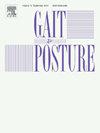Pendulum model to compare center of pressure data between different force plates
IF 2.2
3区 医学
Q3 NEUROSCIENCES
引用次数: 0
Abstract
Background
Force plates are used to measure postural control. However, force plates differ with regard to the type of sensors and the position of the sensors. The purpose of the study was to introduce a method for testing the comparability of two force plates with different force transducers regarding their center of pressure (CoP) capturing.
Methods
Two portable force plates (Kistler Model 9260AA vs. AMTI AccuSway-Optimized ACS-O) were compared. To produce repeatable, close to identical CoP data, a two-point suspension pendulum was used. The deflection angle of the pendulum was kept constant as well as the time of capturing the swing (30 s) and the frequency of capturing the data (1000 Hz). To test for comparability, the captured data was z-transformed and superimposed. Furthermore, interclass correlation coefficient (ICC) estimates, and their 95 % confidence intervals (CI) were calculated.
Results and significance
The ICC for the two tested force plates were "excellent" (x-axis: ICC = 0.990 (95 % CI [0.990–0.990]), y-axis: ICC = 0.987 (95 % CI [0.987–0.988])). Thus, the presented method with the two-point suspension pendulum generated repeatable and almost identical oscillations in the x- and y-axis to calculate the CoP.
Data availability
Data will be made available on request.
求助全文
约1分钟内获得全文
求助全文
来源期刊

Gait & posture
医学-神经科学
CiteScore
4.70
自引率
12.50%
发文量
616
审稿时长
6 months
期刊介绍:
Gait & Posture is a vehicle for the publication of up-to-date basic and clinical research on all aspects of locomotion and balance.
The topics covered include: Techniques for the measurement of gait and posture, and the standardization of results presentation; Studies of normal and pathological gait; Treatment of gait and postural abnormalities; Biomechanical and theoretical approaches to gait and posture; Mathematical models of joint and muscle mechanics; Neurological and musculoskeletal function in gait and posture; The evolution of upright posture and bipedal locomotion; Adaptations of carrying loads, walking on uneven surfaces, climbing stairs etc; spinal biomechanics only if they are directly related to gait and/or posture and are of general interest to our readers; The effect of aging and development on gait and posture; Psychological and cultural aspects of gait; Patient education.
 求助内容:
求助内容: 应助结果提醒方式:
应助结果提醒方式:


